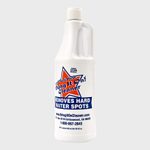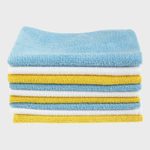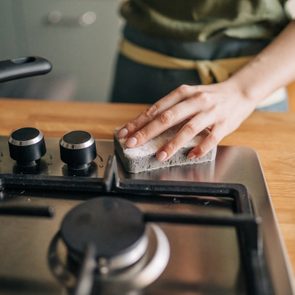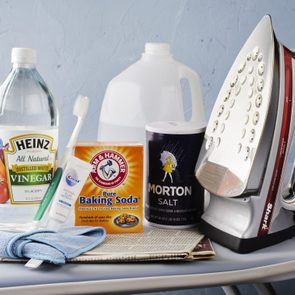How to Clean a Faucet Head (and Why You Really Need To)
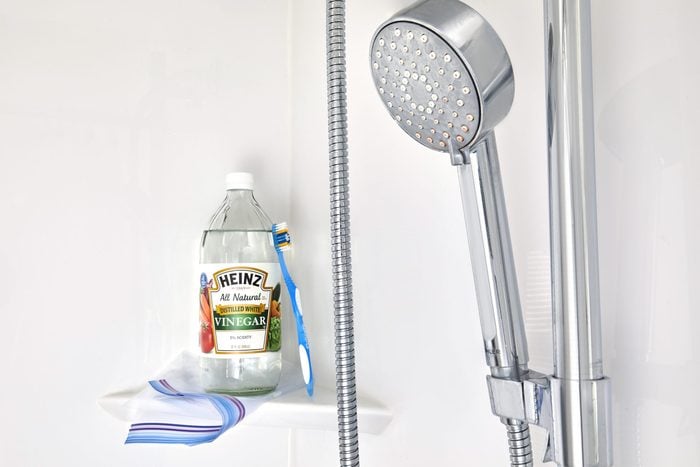
Eventually, everything around the house has to be cleaned—including faucets and showerheads. Simple, step-by-step processes can get them sparkling clean in short order.
Our editors and experts handpick every product we feature. We may earn a commission from your purchases.
When it comes to how to clean, you probably have a handle on things for the most part. How to clean your kitchen and how to clean your kitchen sink. Check. How to clean your bathroom? No worries. How to dust? Been there, wiped that. Floor cleaning? Step right up. In other words, you know the drill. Perhaps you even follow a full-on cleaning schedule. (If so, way to go!) But any cleaning expert worth their weight in scrub brushes will attest that kitchen faucets, bathroom faucets and showerheads aren’t always on the radar. But how to clean a faucet head is worth mastering, especially when it comes to kitchen faucet heads, because they tend to be situated where fruits and vegetables are washed and prepared.
Just like a dirty shower curtain, a dirty showerhead or faucet is a big bummer, and not just because it looks neglected. Faucet heads and showerheads can accumulate grime, minerals and even bacteria. That’s why an important part of cleaning your bathroom is knowing how to clean a showerhead. Ditto for the importance of knowing how to clean a faucet head when you clean your kitchen sink.
“Over time, showerheads can develop calcium, limescale and other mineral buildups from hard water,” explains Vera Peterson, president of Molly Maid. The mineral buildup creates a blockage, making it difficult for water to pass through.
How to clean faucets with vinegar
To do the job quickly and painlessly, follow these step-by-step instructions for how to clean a faucet or showerhead with vinegar, a popular cleaning agent with cleaning maven Melissa Maker, founder of Clean My Space and a YouTuber with more than 2 million subscribers.
Supplies:
- White vinegar
- Quart-size or gallon-size plastic bags
- Rubber band
- OXO Good Grips Deep Clean Brush Set or old toothbrush
Directions:
- Fill a plastic bag about halfway with white vinegar. Use quart-size bags for faucets and gallon-size bags for showerheads. (If you have a large showerhead, you may need to get creative.) “Vinegar is good to use because it is strong enough to dissolve anything that’s left in the head,” notes Peterson. If you prefer to use something besides vinegar, try an over-the-counter product that specifically targets limescale and shower scum.
- Wrap the vinegar-filled bag around the showerhead or faucet so that any place where water exits is completely submerged in the vinegar. Hold the bag in place by snapping a rubber band around it, affixing it to the showerhead or faucet.
- Wait approximately one hour to let the vinegar eat away at any hard-water deposits or calcium buildups.
- After the hour has passed, remove the bag and scrub the faucet or showerhead with a toothbrush to clear up any stubborn residue.
- Rinse by simply running the shower for a few minutes with hot water.
Pro tips: If you turn the shower on and the individual spray holes in the showerhead are still blocked, try poking them with a small tool, like a toothpick. The vinegar will have loosened any buildup so it can be easily dislodged.
If you have any hard-water spots around your sink, Maker suggests putting vinegar on a paper towel or cloth and laying it on the spots. Leave it there for a few hours, then remove. The spots will be gone.
How to clean faucets without vinegar
Supplies:
- A lemon
- Quart-size or gallon-size plastic bags
- Rubber band
- OXO Good Grips Deep Clean Brush Set or old toothbrush
Directions:
For an alternative that doesn’t involve vinegar—and smells spectacularly fresh and zesty—try your hand at a method that’s proven popular on TikTok. The secret? Citrus! All you need is a juicy lemon. Turns out, the acid in the juice naturally makes quick work of any buildup on faucets or showerheads.
- Choose a lemon that feels heavy for its size, an indicator of plenty of juice inside.
- Slice the lemon in half with a sharp knife.
- Use the cut side to thoroughly scrub the faucet or showerhead, concentrating your efforts on any visible buildup.
- Wrap a quart-size or gallon-size plastic bag containing the lemon around the faucet or showerhead. Position the lemon cut side up on the faucet head, then secure in place with a rubber band. Leave it for at least an hour.
- After the hour has passed, if necessary, squeeze the lemon gently to release more juice onto the faucet head, then use the head of a soft toothbrush to work juice into holes and crevices.
- Rinse by simply running the faucet for a minute with hot water.
Pro tip: For really gunky faucets or showerheads, leave the lemon in place overnight.
How to deep-clean faucets and showerheads
Supplies:
- Wrench
- Toothbrush
- Vinegar
- Plumber’s tape
Directions:
- Detach the faucet or showerhead. “For best results, remove the showerhead using a wrench to unscrew the nut located at the shower arm,” Peterson says.
- Next, rinse any loose debris out of the faucet or showerhead by placing it upside down and rinsing with a blast of water.
- If you notice mineral deposits still lodged inside, Peterson recommends using a small brush doused in vinegar to scrub away any deposits. You’ll probably find yourself completing this step if it’s been a while since your last deep-clean.
- Let the faucet or showerhead soak in vinegar overnight.
- Reinstall. Before you do, “wrap plumber’s tape around the shower arm entrance to create a tight seal, then use a wrench to reattach the showerhead to the shower arm,” says Peterson.
- Once the showerhead is reinstalled, turn on the shower for a few minutes to clear out any residual vinegar. You may want to start with a gentle stream and then increase, just in case the showerhead isn’t completely sealed.
Pro tip: Use a rag or microfiber cleansing cloth along with the wrench to protect the finish on the faucet or shower arm, suggests Peterson.
The best faucet head cleaners
How do you remove sediment and buildup from faucets and showerheads?
“The buildup of calcium and magnesium minerals in hard water causes limescale,” says Peterson. You can remove some of it with the quick-clean method outlined above, or you can remove more of it by following the step-by-steps for deep-cleaning. To prevent limescale from building up in the first place, Peterson strongly recommends installing a water softener and maintaining it regularly.
How often should you clean your faucets and showerhead?
Ideally, you should clean the showerhead once a month to remove mineral buildup. A deep-clean should be done at least two times a year but ideally once every four months. This ensures a cleaner showerhead and a more enjoyable showering experience.
Now that you know how to clean your faucet heads and showerheads, find out how to clean other oft-overlooked but important items, including your oven racks and oven glass door.
Additional reporting by Wendy Rose Gold.
Sources:
- Vera Peterson, president of Molly Maid
- Melissa Maker, cleaning expert and founder of Clean My Space




